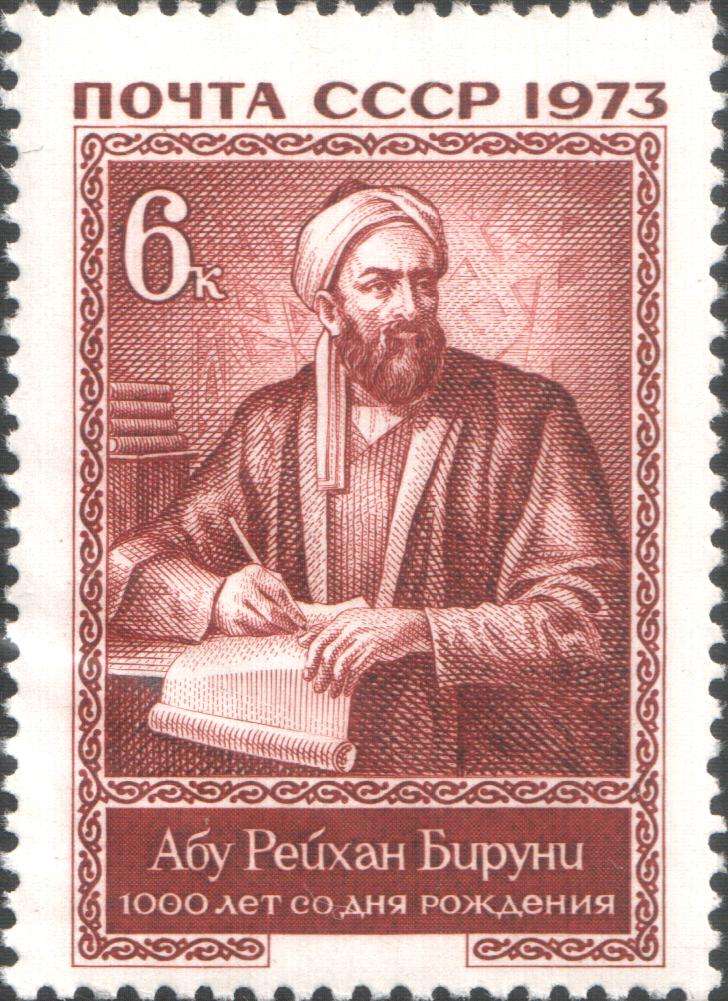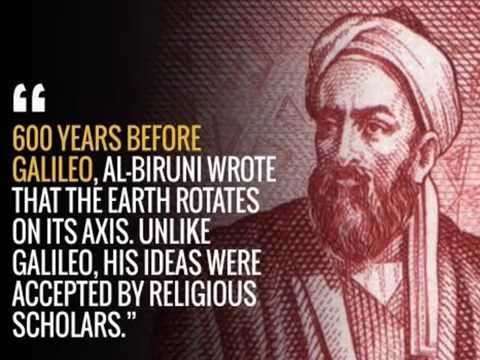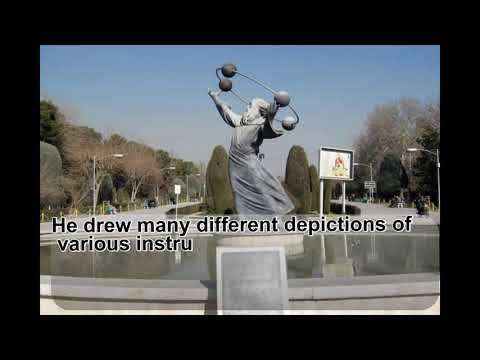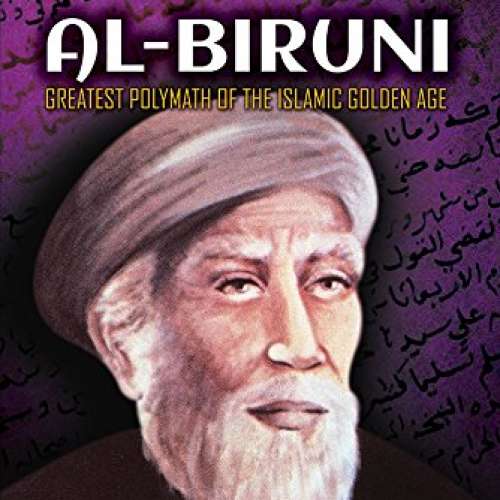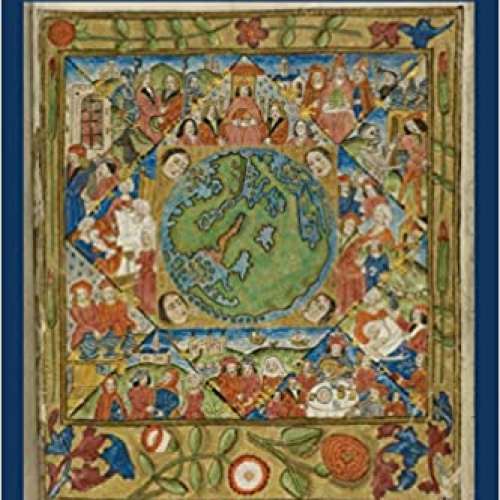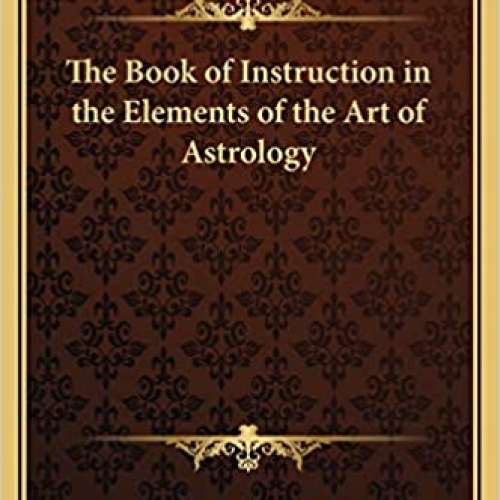

Abu Rayhan al-Biruni (0973-1048)
Once a sage asked why scholars always flock to the doors of the rich, whilst the rich are not inclined to call at the doors of scholars. ‘The scholars‘ he answered , ‘are well aware of the use of money, but the rich are ignorant of the nobility of science.’
Abu Rayhan al-Biruni was an Iranian scholar and polymath during the Islamic Golden Age. He has been variously called as the "founder of Indology", "Father of Comparative Religion", "Father of modern geodesy", and the first anthropologist.
Al-Biruni was well versed in physics, mathematics, astronomy, and natural sciences, and also distinguished himself as a historian, chronologist and linguist. He studied almost all fields of science and was compensated for his research and strenuous work. Royalty and powerful members of society sought out Al-Biruni to conduct research and study to uncover certain findings. In addition to this type of influence, Al-Biruni was also influenced by other nations, such as the Greeks, who he took inspiration from when he turned to studies of philosophy. He was conversant in Khwarezmian, Persian, Arabic, Sanskrit, and also knew Greek, Hebrew and Syriac. He spent much of his life in Ghazni, then capital of the Ghaznavid dynasty, in modern-day central-eastern Afghanistan. In 1017 he travelled to the Indian subcontinent and authored a study of Indian culture Tārīkh al-Hind (History of India) after exploring the Hindu faith practiced in India. He was an impartial writer on customs and creeds of various nations, and was given the title al-Ustadh ("The Master") for his remarkable description of early 11th-century India.
In Iran, Abu Rayhan Biruni's birthday is celebrated as the day of the surveying engineer.
Life
Biruni was born in the outer district (Bīrūn) of Kath, the capital of the Afrighid dynasty of Khwarezm in Central Asia (or Chorasmia). To conduct research, Al-Biruni used different methods to tackle the various fields he studied. He lived during the Islamic Golden Age, when the Abbasid Caliphs promoted the research of astronomy.
Al-Biruni spent the first twenty-five years of his life in Khwarezm where he studied Islamic jurisprudence, theology, grammar, mathematics, astronomy, medicine, philosophy and also dabbled in the field of physics and most other sciences as well. The Iranian Khwarezmian language, which was the language of Biruni, survived for several centuries after Islam until the Turkification of the region, and so must some at least of the culture and lore of ancient Khwarezm, for it is hard to see the commanding figure of Biruni, a repository of so much knowledge, appearing in a cultural vacuum. He was sympathetic to the Afrighids, who were overthrown by the rival dynasty of Ma'munids in 995. He left his homeland for Bukhara, then under the Samanid ruler Mansur II the son of Nuh. There he corresponded with Avicenna and there are extant exchanges of views between these two scholars.
“The difference between you and me is that you’re a philosopher and I’m a [mathematical] scientist.” (Abu Al-Biruni (c.1020), “Letter to Avicenna”)
In 998, he went to the court of the Ziyarid amir of Tabaristan, Shams al-Mo'ali Abol-hasan Ghaboos ibn Wushmgir. There he wrote his first important work, al-Athar al-Baqqiya 'an al-Qorun al-Khaliyya (literally: "The remaining traces of past centuries" and translated as "Chronology of ancient nations" or "Vestiges of the Past") on historical and scientific chronology, probably around 1000 A.D., though he later made some amendments to the book. He also visited the court of the Bavandid ruler Al-Marzuban. Accepting the definite demise of the Afrighids at the hands of the Ma'munids, he made peace with the latter who then ruled Khwarezm. Their court at Gorganj (also in Khwarezm) was gaining fame for its gathering of brilliant scientists.
In 1017, Mahmud of Ghazni took Rey. Most scholars, including al-Biruni, were taken to Ghazni, the capital of the Ghaznavid dynasty. Biruni was made court astrologer and accompanied Mahmud on his invasions into India, living there for a few years. He was forty-four years old when he went on the journeys with Mahmud of Ghazni. Biruni became acquainted with all things related to India. During this time he wrote his study of India, finishing it around 1030. Along with his writing, Al-Biruni also made sure to extend his study to science while on the expeditions. He sought to find a method to measure the height of the sun, and created a makeshift quadrant for that purpose. Al-Biruni was able to make much progress in his study over the frequent travels that he went on throughout the lands of India.
Belonging to the Sunni Ash'ari school, al-Biruni nevertheless also associated with Maturidi theologians. He was however, very critical of the Mu'tazila, particularly criticising al-Jahiz and Zurqan. He also repudiated Avicenna for his views on the eternality of the universe.
Mathematics, astronomy and invention of minutes and seconds
Ninety-five of 146 books known to have been written by Bīrūnī were devoted to astronomy, mathematics, and related subjects like mathematical geography. His religion contributed to his research of astronomy, as in Islam, worship and prayer require knowing the precise directions of sacred locations, which can only be accurately found using astronomical data.
Biruni's major work on astromomy is primarily an astronomical and mathematical text; he states: "I have begun with Geometry and proceeded to Arithmetic and the Science of Numbers, then to the structure of the Universe and finally to Judicial Astrology [sic], for no one who is worthy of the style and title of Astrologer [sic] who is not thoroughly conversant with these for sciences." In these earlier chapters he lays the foundations for the final chapter, on astrological prognostication, which he criticises. He made the first semantic distinction between astronomy and astrology. In a later work, he wrote a refutation of astrology, as opposed to astronomy which he supports. Some suggest that his reasons for refuting astrology were due to the methods used by astrologers being based on pseudoscience rather than empiricism and also due to the views of astrologers conflicting with Sunni Islam.
He wrote an extensive commentary on Indian astronomy in the Taḥqīq mā li-l-Hind mostly translation of Aryabhatta's work, in which he claims to have resolved the matter of Earth's rotation in a work on astronomy that is no longer extant, his Miftah-ilm-alhai'a (Key to Astronomy):
The rotation of the earth does in no way impair the value of astronomy, as all appearances of an astronomic character can quite as well be explained according to this theory as to the other. There are, however, other reasons which make it impossible. This question is most difficult to solve. The most prominent of both modern and ancient astronomers have deeply studied the question of the moving of the earth, and tried to refute it. We, too, have composed a book on the subject called Miftah-ilm-alhai'a (Key to Astronomy), in which we think we have surpassed our predecessors, if not in the words, at all events in the matter.
In his description of Sijzi's astrolabe he hints at contemporary debates over the movement of the earth. He carried on a lengthy correspondence and sometimes heated debate with Ibn Sina, in which Biruni repeatedly attacks Aristotle's celestial physics: he argues by simple experiment that vacuum must exist; he is "amazed" by the weakness of Aristotle's argument against elliptical orbits on the basis that they would create vacuum; he attacks the immutability of the celestial spheres; and so on.
In his major astronomical work, the Mas'ud Canon, Biruni observed that, contrary to Ptolemy, the sun's apogee (highest point in the heavens) was mobile, not fixed. He wrote a treatise on the astrolabe, describing how to use it to tell the time and as a quadrant for surveying. One particular diagram of an eight geared device could be considered an ancestor of later Muslim astrolabes and clocks. More recently, Biruni's eclipse data was used by Dunthorne in 1749 to help determine the acceleration of the moon, and his data on equinox times and eclipses was used as part of a study of Earth's past rotation.
Al-Biruni was the person who first subdivided the hour sexagesimally into minutes, seconds, thirds and fourths in 1000 while discussing Jewish months.
Refutation of Eternal Universe
Similar to later Asharis, such as al-Ghazali, al-Biruni is famous for vehemently defending the majority Sunni position that the universe has a beginning, being a strong supporter of creatio ex nihilo, specifically refuting the philosopher Avicenna in a multiple letter correspondence.
Al-Biruni stated the following,
Other people, besides, hold this foolish persuasion, that time has no terminus quo at all
He further stated that Aristotle, whose arguments Avicenna uses, contradicted himself when he stated that the universe and matter has a start whilst holding on to the idea that matter is pre-eternal. In his letters to Avicenna, he stated the argument of Aristotle, that there is a change in the creator. He further argued that stating there is a change in the creator would mean there is a change in the effect (meaning the universe has change) and that the universe coming into being after not being is such a change (and so arguing there is no change - no beginning - means Aristotle believes the creator is negated).
Al-Biruni was proud of the fact that he followed the textual evidence of the religion without being influenced by Greek philosophers such as Aristotle.
Physics
Al-Biruni contributed to the introduction of the scientific method to medieval mechanics. He developed experimental methods to determine density, using a particular type of hydrostatic balance.
Geography and Geodesy
Bīrūnī devised a novel method of determining the earth's radius by means of the observation of the height of a mountain. He carried it out at Nandana in Pind Dadan Khan (present-day Pakistan). He used trigonometry to calculate the radius of the Earth using measurements of the height of a hill and measurement of the dip in the horizon from the top of that hill. His calculated radius for the Earth of 3928.77 miles was 2% higher than the actual mean radius of 3847.80 miles. His estimate was given as 12,803,337 cubits, so the accuracy of his estimate compared to the modern value depends on what conversion is used for cubits. The exact length of a cubit is not clear; with an 18 inch cubit his estimate would be 3,600 miles, whereas with a 22 inch cubit his estimate would be 4,200 miles. One significant problem with this approach is that Al-Biruni was not aware of atmospheric refraction and made no allowance for it. He used a dip angle of 34 arc minutes in his calculations, but refraction can typically alter the measured dip angle by about 1/6, making his calculation only accurate to within about 20% of the true value.
In his Codex Masudicus (1037), Al-Biruni theorized the existence of a landmass along the vast ocean between Asia and Europe, or what is today known as the Americas. He argued for its existence on the basis of his accurate estimations of the Earth's circumference and Afro-Eurasia's size, which he found spanned only two-fifths of the Earth's circumference, reasoning that the geological processes that gave rise to Eurasia must surely have given rise to lands in the vast ocean between Asia and Europe. He also theorized that at least some of the unknown landmass would lie within the known latitudes which humans could inhabit, and therefore would be inhabited.
Pharmacology and mineralogy
Biruni wrote a pharmacopoeia, the "Kitab al-saydala fi al-tibb" (Book on the Pharmacopoeia of Medicine). It lists synonyms for drug names in Syriac, Persian, Greek, Baluchi, Afghan, Kurdi, and some Indian languages.
He used a hydrostatic balance to determine the density and purity of metals and precious stones. He classified gems by what he considered their primary physical properties, such as specific gravity and hardness, rather than the common practice of the time of classifying them by colour.
History and chronology
Biruni's main essay on political history, Kitāb al-musāmara fī aḵbār Ḵᵛārazm (Book of nightly conversation concerning the affairs of Ḵᵛārazm) is now known only from quotations in Bayhaqī's Tārīkh-e Masʿūdī. In addition to this various discussions of historical events and methodology are found in connection with the lists of kings in his al-Āthār al-bāqiya and in the Qānūn as well as elsewhere in the Āthār, in India, and scattered throughout his other works. Al-Biruni's “Chronology of Ancient Nations” attempted to accurately establish the length of various historical eras.
History of religions
Bīrūnī is one of the most important Muslim authorities on the history of religion. Al-Biruni was a pioneer in the study of comparative religion. He studied Zoroastrianism, Judaism, Hinduism, Christianity, Buddhism, Islam, and other religions. He assumed the superiority of Islam: "We have here given an account of these things in order that the reader may learn by the comparative treatment of the subject how much superior the institutions of Islam are, and how more plainly this contrast brings out all customs and usages, differing from those of Islam, in their essential foulness." However he was happy on occasion to express admiration for other cultures, and quoted directly from other religions' sacred texts when reaching his conclusions. He strived to understand them on their own terms rather than trying to prove them wrong. His underlying concept was that all cultures are at least distant relatives of all other cultures because they are all human constructs. "Rather, what Al-Biruni seems to be arguing is that there is a common human element in every culture that makes all cultures distant relatives, however foreign they might seem to one another."
Al-Biruni divides Hindus into an educated and an uneducated class. He describes the educated as monotheistic, believing that God is one, eternal, and omnipotent and eschewing all forms of idol worship. He recognizes that uneducated Hindus worshiped a multiplicity of idols yet points out that even some Muslims (such as the Jabiriyya) have adopted anthropomorphic concepts of God.
Anthropology
Al-Biruni wrote about the peoples, customs and religions of the Indian subcontinent. According to Akbar S. Ahmed, like modern anthropologists, he engaged in extensive participant observation with a given group of people, learnt their language and studied their primary texts, presenting his findings with objectivity and neutrality using cross-cultural comparisons. Akhbar S. Ahmed concluded that Al-Biruni can be considered as the first Anthropologist, however, others argue that he hardly can be considered an anthropologist in the conventional sense.
Indology
Al-Biruni's fame as an Indologist rests primarily on two texts. Al-Biruni wrote an encyclopedic work on India called Taḥqīq mā li-l-Hind min maqūlah maqbūlah fī al-ʿaql aw mardhūlah (variously translated as "Verifying All That the Indians Recount, the Reasonable and the Unreasonable" or "The book confirming what pertains to India, whether rational or despicable") in which he explored nearly every aspect of Indian life, including religion, history, geography, geology, science, and mathematics. During his journey through India, military and political histories were not of Al-Biruni's main focus. Instead, he decided to document the more civilian and scholarly areas of Hindu life such as culture, science, and religion. He explores religion within a rich cultural context. He expresses his objective with simple eloquence: He also translated the works of Indian sage Patanjali with the title Tarjamat ketāb Bātanjalī fi’l-ḵalāṣ men al-ertebāk.
An example of Al-Biruni's analysis is his summary of why many Hindus hate Muslims. Biruni notes in the beginning of his book how the Muslims had a hard time learning about Hindu knowledge and culture. He explains that Hinduism and Islam are totally different from each other. Moreover, Hindus in 11th century India had suffered waves of destructive attacks on many of its cities, and Islamic armies had taken numerous Hindu slaves to Persia, which—claimed Al-Biruni—contributed to Hindus becoming suspicious of all foreigners, not just Muslims. Hindus considered Muslims violent and impure, and did not want to share anything with them. Over time, Al-Biruni won the welcome of Hindu scholars. Al-Biruni collected books and studied with these Hindu scholars to become fluent in Sanskrit, discover and translate into Arabic the mathematics, science, medicine, astronomy and other fields of arts as practiced in 11th-century India. He was inspired by the arguments offered by Indian scholars who believed earth must be globular in shape, which is the only way to fully explain the difference in daylight hours by latitude, seasons and earth's relative positions with moon and stars. At the same time, Al-Biruni was also critical of Indian scribes who he believed carelessly corrupted Indian documents while making copies of older documents. He also criticized the Hindus on what he saw them do and not do, like their deficiencies in curiosity about history and religion.

One of the specific aspects of Hindu life that Al-Biruni studied was the Hindu calendar. His scholarship on the topic exhibited great determination and focus, not to mention the excellence in his approach of the in-depth research he performed. He developed a method for converting the dates of the Hindu calendar to the dates of the three different calendars that were common in the Islamic countries of his time period, the Greek, the Arab/Muslim, and the Persian. Biruni also employed astronomy in the determination of his theories, which were complex mathematical equations and scientific calculation that allows one to convert dates and years between the different calendars.
The book does not limit itself to tedious records of battle because Al-Biruni found the social culture to be more important. The work includes research on a vast array of topics of Indian culture, including descriptions of their traditions and customs. Although he tried to stay away from political and military history, Biruni did indeed record important dates and noted actual sites of where significant battles occurred. Additionally, he chronicled stories of Indian rulers and told of how they ruled over their people with their beneficial actions and acted in the interests of the nation. But, his details are brief and mostly just list rulers without referring to their real names. He did not go on about deeds that each one carried out during their reign, which keeps in line with Al-Biruni's mission to try to stay away from political histories. Al-Biruni also described the geography of India in his work. He documented different bodies of water and other natural phenomena. These descriptions are useful to today's modern historians because they are able to use Biruni's scholarship to locate certain destinations in modern-day India. Historians are able to make some matches while also concluding that certain areas seem to have disappeared and been replaced with different cities. Different forts and landmarks were able to be located, legitimizing Al-Biruni's contributions with their usefulness to even modern history and archeology.
Once a sage asked why scholars always flock to the doors of the rich, whilst the rich are not inclined to call at the doors of scholars.
The dispassionate account of Hinduism given by Al-Biruni was remarkable for its time. He stated that he was fully objective in his writings, remaining unbiased like a proper historian should. Biruni documented everything about India just as it happened. But, he did note how some of the accounts of information that he was given by natives of the land may not have been reliable in terms of complete accuracy, however, he did try to be as honest as possible in his writing. Dr. Edward C. Sachau compares it to "a magic island of quiet, impartial research in the midst of a world of clashing swords, burning towns, and plundered temples." Biruni's writing was very poetic, which may diminish some of the historical value of the work for modern times. The lack of description of battle and politics makes those parts of the picture completely lost. However, Many have used Al-Biruni's work to check facts of history in other works that may have been ambiguous or had their validity questioned.
Works
Most of the works of Al-Biruni are in Arabic although he seemingly wrote the Kitab al-Tafhim in both Persian and Arabic, showing his mastery over both languages. Bīrūnī's catalogue of his own literary production up to his 65th lunar/63rd solar year (the end of 427/1036) lists 103 titles divided into 12 categories: astronomy, mathematical geography, mathematics, astrological aspects and transits, astronomical instruments, chronology, comets, an untitled category, astrology, anecdotes, religion, and books he no longer possesses.
Persian work
Biruni wrote most of his works in Arabic, as the scientific language of his age, however, his Persian version of the Al-Tafhim is one of the most important of the early works of science in the Persian language, and is a rich source for Persian prose and lexicography. The book covers the Quadrivium in a detailed and skilled fashion.
Legacy
After Al-Biruni's death, in the Ghaznavid dynasty and following centuries his work was not built on, nor referenced. It was only hundreds of years later in the West, that his books became read and referenced again, especially his book on India which became relevant to the British Empire's activity in India from the 17th century.
A film about his life, Abu Raykhan Beruni, was released in the Soviet Union in 1974.
Lunar crater Al-Biruni, on the far side of the Moon, as seen by Apollo 14
The lunar crater Al-Biruni and the asteroid 9936 Al-Biruni were named in his honour.
In June 2009, Iran donated a pavilion to the United Nations Office in Vienna—placed in the central Memorial Plaza of the Vienna International Center. Named the Scholars Pavilion, it features the statues of four prominent Iranian scholars: Avicenna, Abu Rayhan Biruni, Zakariya Razi (Rhazes) and Omar Khayyam.


